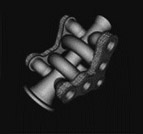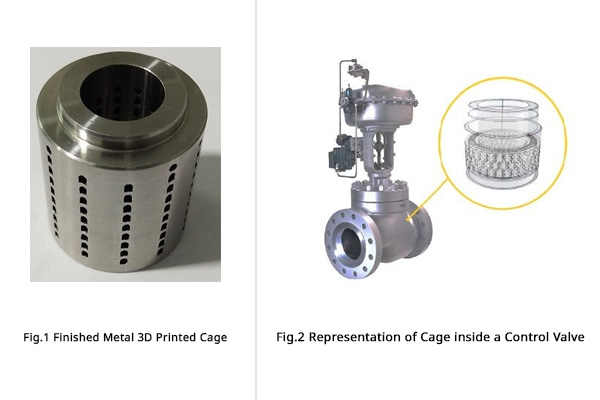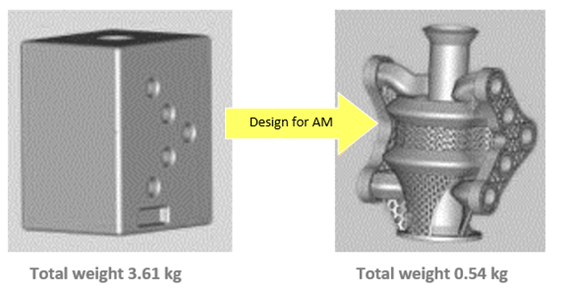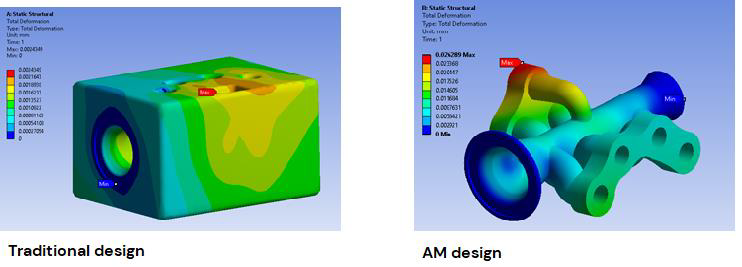Additive manufacturing of hydraulic application components, like
hydraulic manifold block, End fittings, accessories, is a powerful alternative to
traditional manufacturing methods such as machining and casting. Additive Manufacturing
allows a much higher level of design freedom, part integration, to reduce weight and
improve the media flow paths with varied geometry shape and size (shape) of internal
channels for ideal flow by maintaining the structural integrity.
Hydraulic manifold blocks are crucial elements of hydraulic systems
and usually have a conventional compact, square design with multiple internal channels
in straight lines that enable them to control the fluid distribution of large machines
or systems in automotive or industrial safety equipment.
Conventional manufacturing of Hydraulic manifold block
The traditional manufacturing of hydraulic manifold blocks causes
very high machining costs with milling and drilling operations to create the internal
fluid channels that are in straight lines or angular lines leading to high costs and,
long lead time. (Which causes high machining costs.)
The challenges and disadvantages of traditional Hydraulic manifolds
- Abrupt angled junctions between flow paths can
cause flow stagnation with dead legs and an increase in hold-up volume resulting in
loss of flow efficiency.
- The edges create stresses which are not loosened
and cannot be removed while in operation.
- Dirt reservoirs are formed at areas with no fluid
flow causing damage to failure to the whole system.
- The waiting period for a new hydraulic manifold
block in case of failure leads to machine downtime losing a high rate of MHR.
Advantages for Printing in AM:
- Reduction in Build time
- Reduction in Material consumption
- Reduced post processing & support removal
- Increased Efficiency
- No leakage in operation
Intech Additive reduced the weight of the hydraulic manifold block from 3.61
to 0.51kg down by 3.10kg
Improved flow efficiency
The horizontal holes are no longer needed, the fluid can now flow around the corner and
is not disturbed by corners and edges.
- Homogeneous wall thickness
- Design flexibility
- No Leakage risks
- No stress risks
- Smooth channels for optimal flow
- Light weight
- Improves energy efficiency and
reliability

The final hydraulic manifold block redesigned in additive
manufacturing.
Design for Additive Manufacturing (DfAM)
With a more complex hydraulic manifold block, it is possible to adjust the fluid
channel lengths to each other. AM provides a flexible design option for shorter
channel flow paths to avoid losses against the longer fluid channel and less risk of
leakage. Shorter channels and no sharp corners mean higher energy efficiency.
Advantages of Design for AM
- The wall thicknesses can be
adjusted as required.
- Rapid design repetitions and no
tooling costs.
Optimize the flow path with AM
- AM allows users more time to
change the design decision.
- Total flexibility and adjust the
design at any time.
About the Author
Gregg Profozich
Gregg Profozich is a manufacturing, operations and technology executive who believes that
manufacturing is the key creator of wealth in the economy and that a strong manufacturing
sector is critical to our nation’s prosperity and security now, and for future generations.
Across his 20-year plus career in manufacturing, operations and technology consulting, Mr.
Profozich helped manufacturing companies from the Fortune 500 to the small, independents
significantly improve their productivity and competitiveness.





